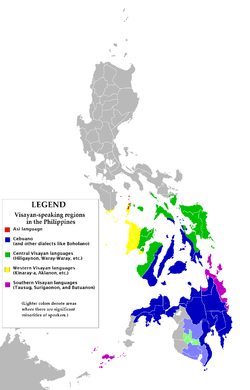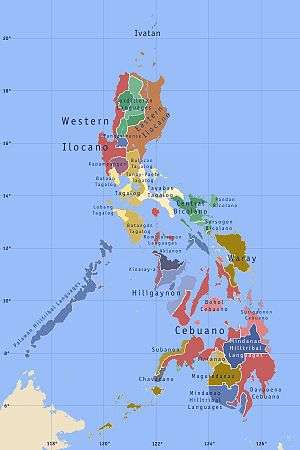Bible translations into the languages of the Philippines
The Filipino language, based on the Tagalog language (the major dialect), is national language of the Philippines. The Christian Bible has been translated into numerous Philippine languages.
Tagalog
Portions of the Sacred Scriptures were first translated by the Spanish friars into the Philippine languages in the catechisms they published, and the prayer materials they produced. A fine example would be the "Pater Noster" in Tagalog Baybayin Script in the first book published (by xylography) in the Philippines, the Doctrina Cristiana (1593).
Protestants published 'Ang Biblia' in 1905 in Tagalog, according to the Protestant canon. Translators based their work on a Spanish version.
Msgr. Jose C. Abriol, Filipino Catholic priest, translated from Hebrew and Greek into Tagalog.
Most Protestant denominations use the New International Version of the Bible (now on Filipino version), owing to the fact that English is also the official language of the Philippines. Nonetheless, most Mainline Protestant denominations in the Philippines tend to prefer the Magandang Balita Biblia (Good News Bible). The Iglesia ni Cristo also uses the same translation.
Jehovah's Witnesses or Mga Saksi ni Jehova uses their own translation of Bible called New World Translation that is published in Filipino languages Tagalog, Cebuano, Hiligaynon and other 100+ languages since 1980's.
Versions
- Ang Salita ng Dios® 2010© (Filipino version of the New International Version® NIV®), produced by Biblica® Publishing & Distribution Foundation, Inc.® Ang Salita ng Dios® ay isang bagong salin ng Biblia sa Pilipino. Bunga ito ng matagal na panahong pagtatrabaho ng translators at reviewers na nanggaling sa iba't ibang Christian denominations. Ang bagong saling ito ay ibinatay sa orihinal na wika ng Biblia na Hebreo at Griego, dumaan sa masusing proseso at isinalin sa mga salitang ginagamit sa mga pang araw-araw na pakikipag-usap; upang makatulong sa pampubliko at pribadong pagbabasa ng Biblia, gayundin sa pagtuturo at pagpapahayag nito, at sa iba pang paglilingkod sa simbahan.
- Ang Bagong Ang Biblia - The Tagalog version. Many archaic and classical words were replaced with more common and modern equivalents, but more formal. Full text
- Ang Biblia, 1975
- Ang Biblia - New Pilipino Version, 1986, Manila International Bible Society (now Biblica)
- Ang Biblia ng Sambayanang Pilipino Full text
- Ang Dating Biblia, older version of Ang Biblia (Bible written in classical Tagalog) translated in 1905
- Ang Magandang Balita Biblia, 1973
- Ang Magandang Balita Biblia, 2005 edition
- Ang Salita ng Diyos, 1998: New Testament only; produced by Bibles International Full text
- Bagong Sanlibutang Salin ng Banal na Kasulatan, 1985, 2013 Edition. Whole Bible translation produced by Watchtower Bible and Tract Society of the Philippines and Watchtower Bible and Tract Society of New York Inc. Full text
Regional languages
Other languages of the Philippines:

- Asi – spoken in towns on Tablas Island as well as the islands of Banton, Simara, and Maestro de Campo in Romblon province. It is known officially as Bantoanon language.
- Cebuano – includes Boholano, Leytehanon, Mindanao Cebuano and Mindanao Visayan dialects.
- Surigaonon (including Jaun-Jaun). May be closest to Cebuano.[1]
- Central Visayan – includes:
- Hiligaynon
- Waray - two modern Bible translations[2]
- Romblomanon which includes Sibuyan various dialects of Cajidiocanon, San Fernando-Azagra Sibujanon and the Magdiwang-Espana Sibuyanon variety, Ati, Capiznon, Masbatenyo, Porohanon, the Bisakol languages of Sorsogon and Northern Samar, and others.
- Western Visayan – includes:
- Kinaray-a (the major language of Antique),
- Aklan languages (Aklanon, Malaynon),
- Onhan or Loocnon (Tablas)- Eldon Leano Talamisan, 1999 (New Testament), Philippines, into the Onhan language or Bisaya-Inunhan
- Caluyanon,
- Cuyonon,
- Ratagnon,
- and others.
- Tausug – spoken in Jolo, Sulu; Palawan; Basilan; Tawi-Tawi; and Zamboanga City and environs. Also spoken in Indonesia (Kalimantan), and Malaysia (Sabah). It has been suggested to be more closely related to the Mansakan languages than to Visayan.
Ilocano
References
- ↑ Austronesian Basic Vocabulary Database
- ↑ Concise encyclopedia of languages of the world - Page 915 Keith Brown, Sarah Ogilvie "Waray is the language of the church throughout the Eastern Visayas region, and by far the most readily available literature in Waray is religious in nature, including two modern Bible translations and numerous prayer pamphlets.
